Hyundai Ioniq 5 N vs. BMW M3: Can an EV Match the Performance-Car Benchmark?
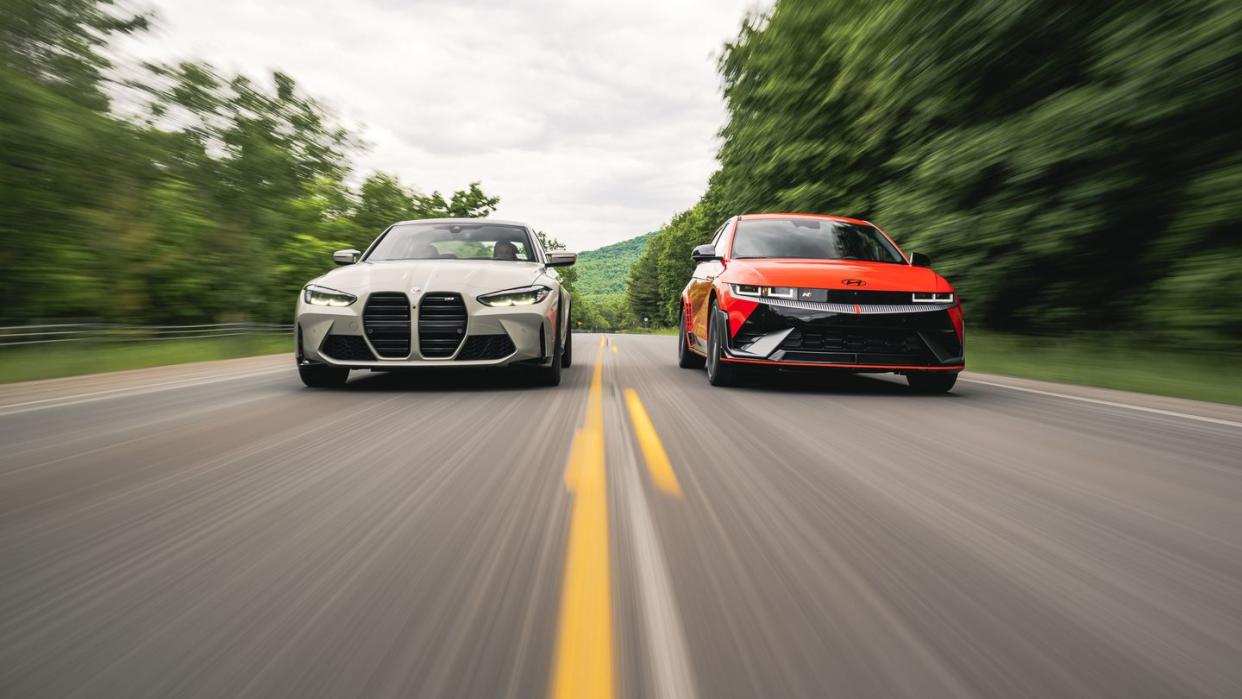

“If someone who owns an M3 wants to try out electric performance and gets into a 5 N, they won’t be disappointed,” digital director Aaron Brown says. Coming to that conclusion is precisely why we brought this slate gray, manual-transmission BMW together with an electric orange Hyundai. We know EVs can be quick. There are a million Tesla drag-strip videos to prove that. But the 5 N is the first mainstream EV to position itself as a factory- tuned machine that’s fun to drive. Can the 5 N really be as rewarding and entertaining as a traditional gas-burning performance car?
With upgraded hardware and software, a totally revised suspension, and an electronic limited-slip differential, the 5 N is unique in the electric-car market. This kind of treatment is new for an EV, but it’s familiar territory for the car world at large. This is the modern internal-combustion performance-car formula applied to an EV platform.
Representing ICE Performance: The Manual BMW M3
Comparing the 5 N favorably against a BMW M3 is an achievement in and of itself. And if I’m being honest, that praise feels more meaningful after getting reacquainted with the M3. I went into this driving day wondering if the BMW was a fair representative of internal combustion against the 5 N’s new prospect of the all-electric performance car.

But a few runs on the deserted mountain roads up in the Catskills, among the reservoirs that supply New York City a few hours south, reminds me how much I like the M3.

Some of that, surely, is that we’re driving the base-model M3, with rear-wheel drive and a manual transmission. There are no track-day-special ultra-low-profile tires; there are no paddle shifters. Just a remarkably resolved chassis, three pedals, and trust that you know enough not to get yourself into too much trouble.
There is a very real feel to this car, the M3. No slop in the suspension, every facet of the controls clean and precise in operation. It drives solid, with loads of front-end grip and a back end that always follows through. Even on the most up-and-down road, crusty and undulating with dips and whoops, the M3 is locked in.
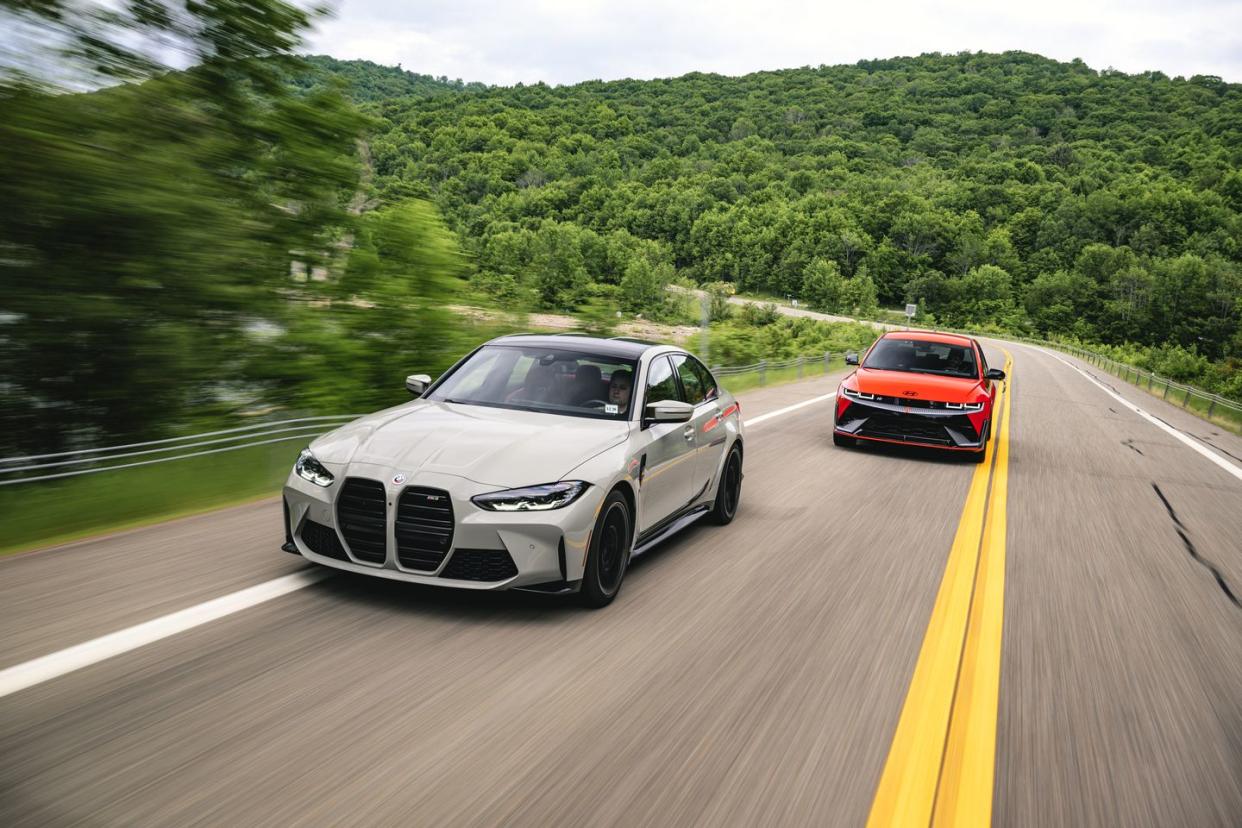
As much as car enthusiasts like to rag on the M3 for being so much bigger than it used to be, with more and more digital controls and settings, it’s shocking how rewarding it is to drive. It’s lithe, even if I wouldn’t call it light. It’s not up on its toes; it’s planted. You lean on it, count on it, revel in how the straight-six sings.
Just be mindful to gently ease off the gas when you’re passing somebody’s house. It feels a little rude to let all the exhaust’s pops and crackles shatter the silence of these otherwise-peaceful rural two-lanes.
Even if it doesn’t drive like a featherweight the M3 is the lighter car of this pair, around 1000 pounds lighter than the Ioniq 5 N, weighing in around 3800. No surprise, then, that these two cars feel equally fast. The Ioniq 5 N makes do with 641 hp to the M3’s 470-odd hp. It has 568 lb-ft of torque against the M3’s 406. Two electric motors deliver the 5 N’s power front and rear, while the M3 has only the rear wheels to put things to the ground.
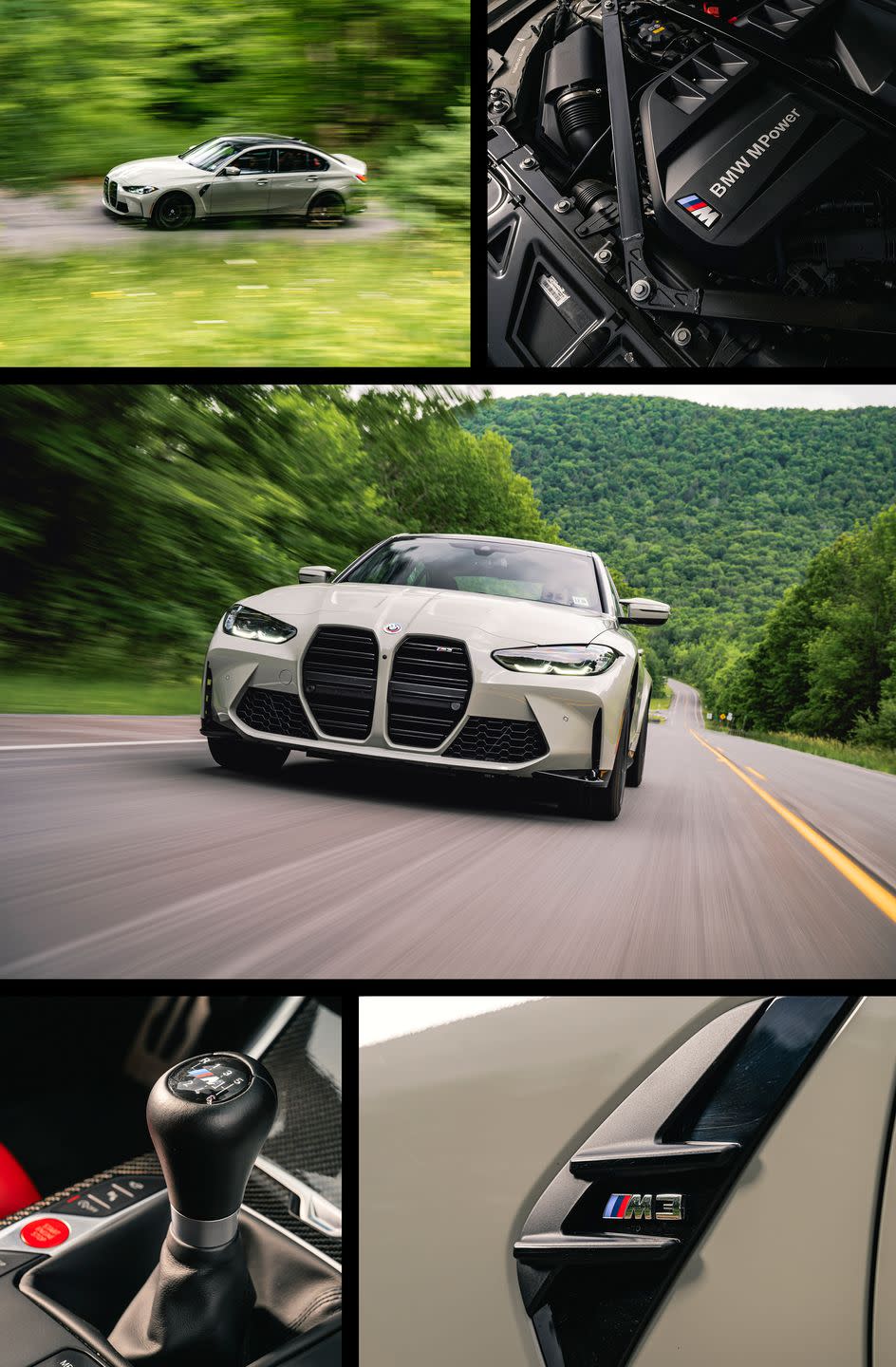
Both follow the same visual recipe in terms of visual cues to the tuned mechanicals. The M3’s body is lightly beefed up, with a deeper face and beefier fenders. The 5 N gets the similar treatment, with chunkier fenders, little wings, and a deep front bumper to pull air for the front and rear motors (the latter new to the 5 N), as well as a new electronically controlled limited-slip differential at the rear, borrowed from the Veloster N and Elantra N but reinforced for the added torque. Both these cars are similarly uprated from their purely family-car origins and end up at a similar price range. The M3 starts at $77,175 and the 5 N is almost exactly 10 grand cheaper, starting at $67,475. Plenty of cash left over to install a home charger.
By the standards of the Platonic sports-car ideal, it’s the M3 that is the more honorable car. There is less weight, and there is still the direct, mechanical connection of engine to transmission by the clutch pedal at your feet. And you feel it. For all of its digital systems—as we’d expect from a 21st-century car—driving this M3 is a mechanical experience, brutish as it jets across the road ahead. It pushes you, and it is outstandingly resolved.
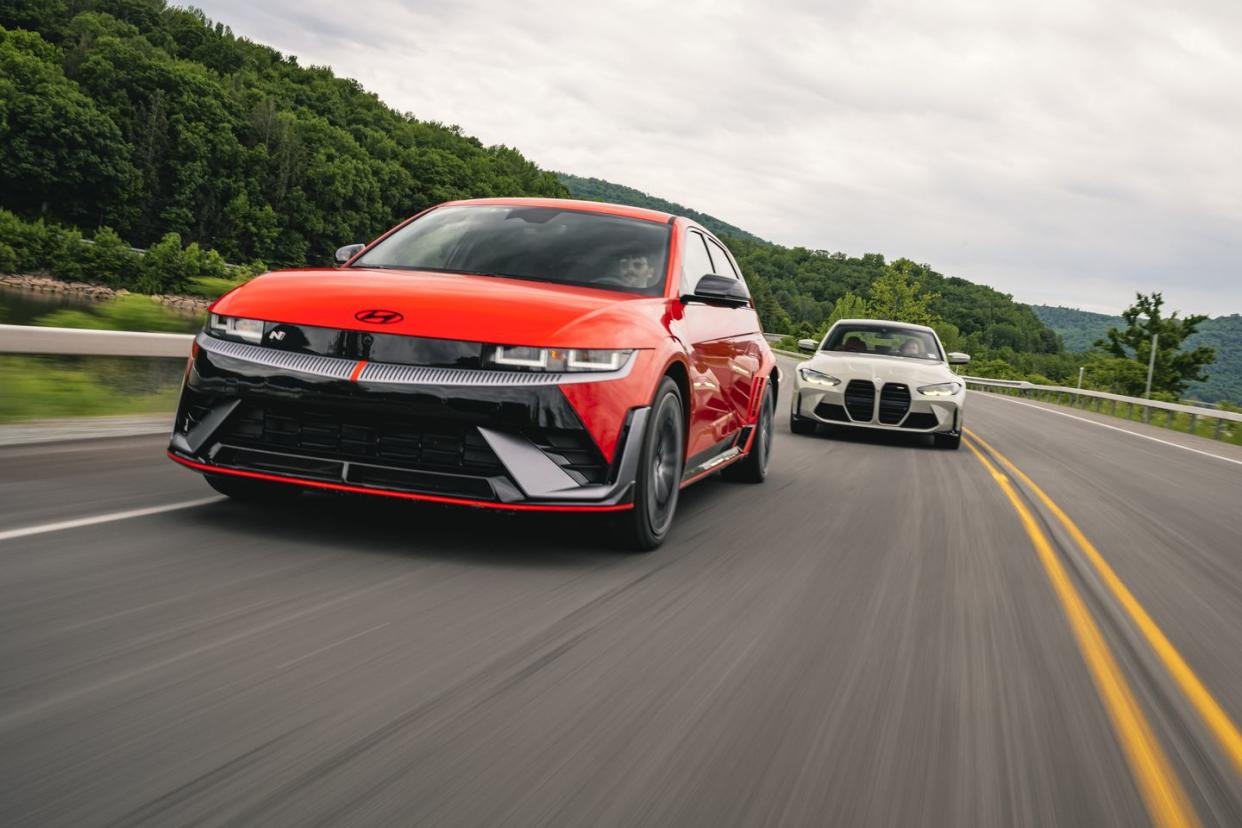
And the BMW is incredibly aggressive if you select the right modes. The key is to set the customizable M mode to keep the engine in its most aggressive Sport+ setting, which is worth the dive into the settings menu. When it’s clicked off, you can mash the gas pedal to the floor with little response. With it clicked on, the car barks with every millimeter of throttle travel.
Representing the EV Newcomer: The Hyundai Ioniq 5 N
A big part of why the 5 N is the perfect foil to the M3 is that the Hyundai is also filled with modes and settings, little things to tweak. Remember that the development of the 5 N was led by the old boss of BMW M, and some of his top staff also ended up there as well. Hyundai's customizable setting is called N mode, which seems like a sly wink being one letter further down the alphabet. It also can be toggled on and off from the steering wheel. You can tweak the suspension, steering, and traction and stability controls, as well as the response of the electric motors. Temp gauges for them and the battery are right in your face on the digital gauge cluster, a reminder that this is a beefed-up car with some envelope-pushing performance targets.

Hyundai’s N team says that this car will do two laps of the Nürburgring Nordschleife, where their team is headquartered. No other EV manufacturer makes this claim. Not BMW, not Porsche, nobody. The aggressive cooling at the front of the 5 N speaks to the challenge of running the 12.9-mile Ring twice without incident.
In a way, it’s a serious car with a serious set of performance targets to hit.
There’s a gimmicky side to the 5 N, with enough simulation to make Baudrillard’s head spin. Also toggled from a button on the steering wheel and in the car’s menu screen are simulated shifting and a simulated engine, complete with a strict redline. In the right mode, the car will hit the rev limiter at a simulated 8000 rpm on the digital tachometer. (In actuality, the 5 N’s electric motors spin up to 21,000 rpm.) It’ll just sit there, in its fake gear, held back by software code mimicking the physical limitations of internal combustion. The 5 N even jolts on a hard shift.
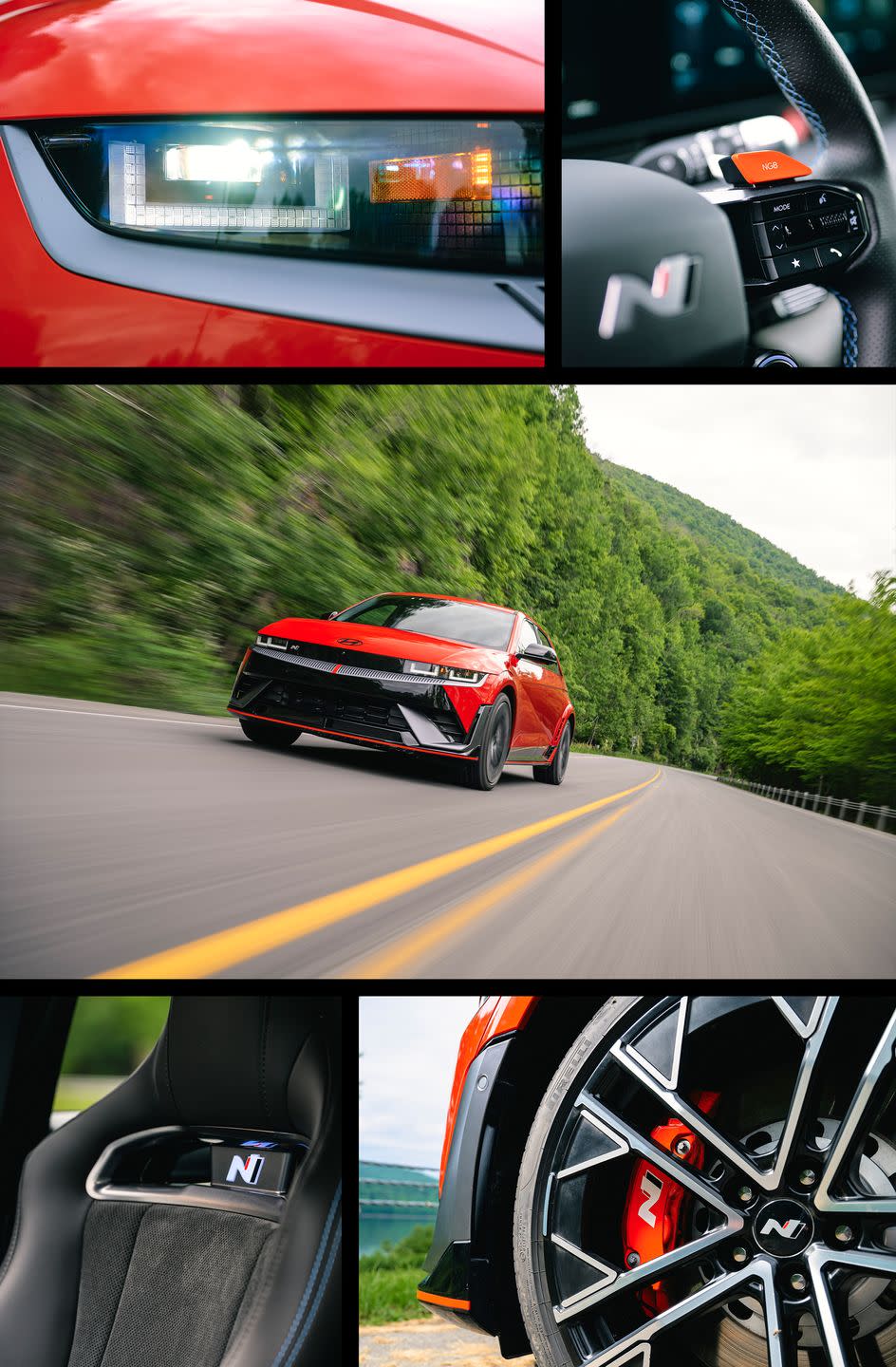
The idea is that the all-electric 5 N provides the same inputs and outputs as you get when driving internal-combustion cars hard, particularly on-track where you watch only the road ahead of you, listening and feeling for how the car reacts, judging your speed by engine tone in a given gear. All this fakery might seem goofy, sure, but there is a practicality to it. It’s designed so that anyone without EV experience can hop into the 5 N and be fast.
As for me, to really enjoy a road I turn that all off and tune into the EV's inherent audible feedback. I relish the feeling of electric torque hauling me down the road like the tide pulling me out to sea. I listen for the high-pitched whine of the electric motors. Yes, you can hear them, sharp like a dentist’s drill. Raw and a little scary. You can even hear the tires, scrubbing away at the pavement.
The electric drivetrain allows for distinct tweaks to the settings, and it seems like the N engineers found ways to celebrate those differences. The 5 N does things that even a gas-burning version of the same car would struggle to do. In the right mode, you can change the torque split front to rear: all the way front, all the way rear, or any amount in between. I pull the slider to 20 percent front, 80 percent rear, and the car comes alive.
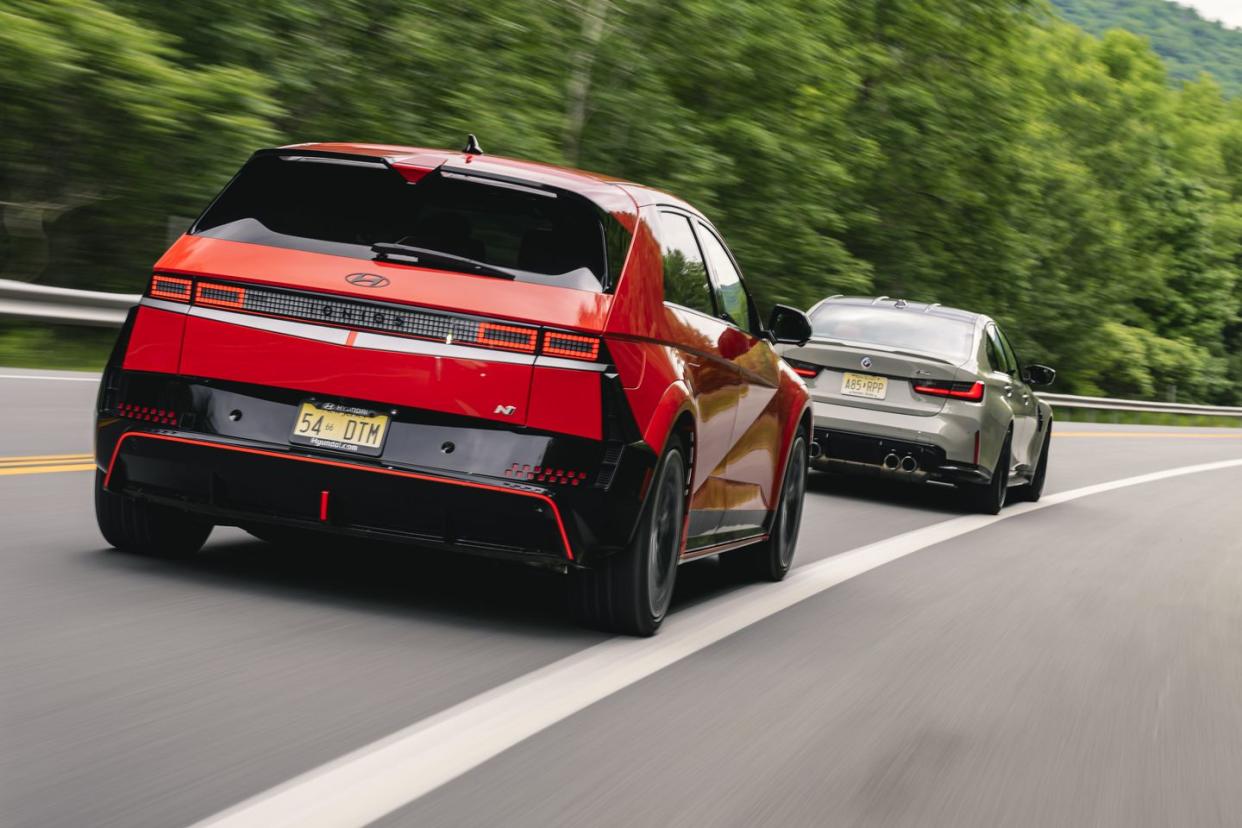
As the nose of the Hyundai dives into a corner, the rear tucks in with it. The 5 N is shockingly responsive down a tight road, and the car almost leaps from corner to corner. If the BMW was this darty, 90 percent of the people who buy one would crash it. The M3 has to be tuned to be stable. With that much power and just rear-wheel drive, planted predictability is essential. It's a requirement that results in a serious car more than a playful one, at least on public roads. Don’t get me wrong, the M3 is fast and meant to be driven hard. It’s just not obliquely fun.
The 5 N? You play with it, feel it move around you. The 5 N is one of the best-handling cars on the market, not just for an overgrown hot hatch, not just for an electric car. N tunes its cars so well, beyond just being sharp, beyond just having good body control. Anyone who has driven a Veloster N, or an Elantra N, will know this kind of sensation. The difference with the Ioniq is that this attitude is graduated up from 200-odd hp and front-wheel drive to over 600 hp and big, real, all-wheel-drive speed.
What These Cars Mean
In terms of outright pace, there’s little question the 5 N is more than a match for the BMW, and it holds on, mile after mile. That resilience is aided in part by the 800-volt architecture, which increases the drivetrain's efficiency and reduces heat and stress on the whole system. N engineers admitted to me when I drove the prototype of this car in 2023 that they wouldn’t have been able to make it work without that 800-volt base or the efficient silicon-carbide inverters Hyundai uses that rivals (like BMW’s i4) do not.
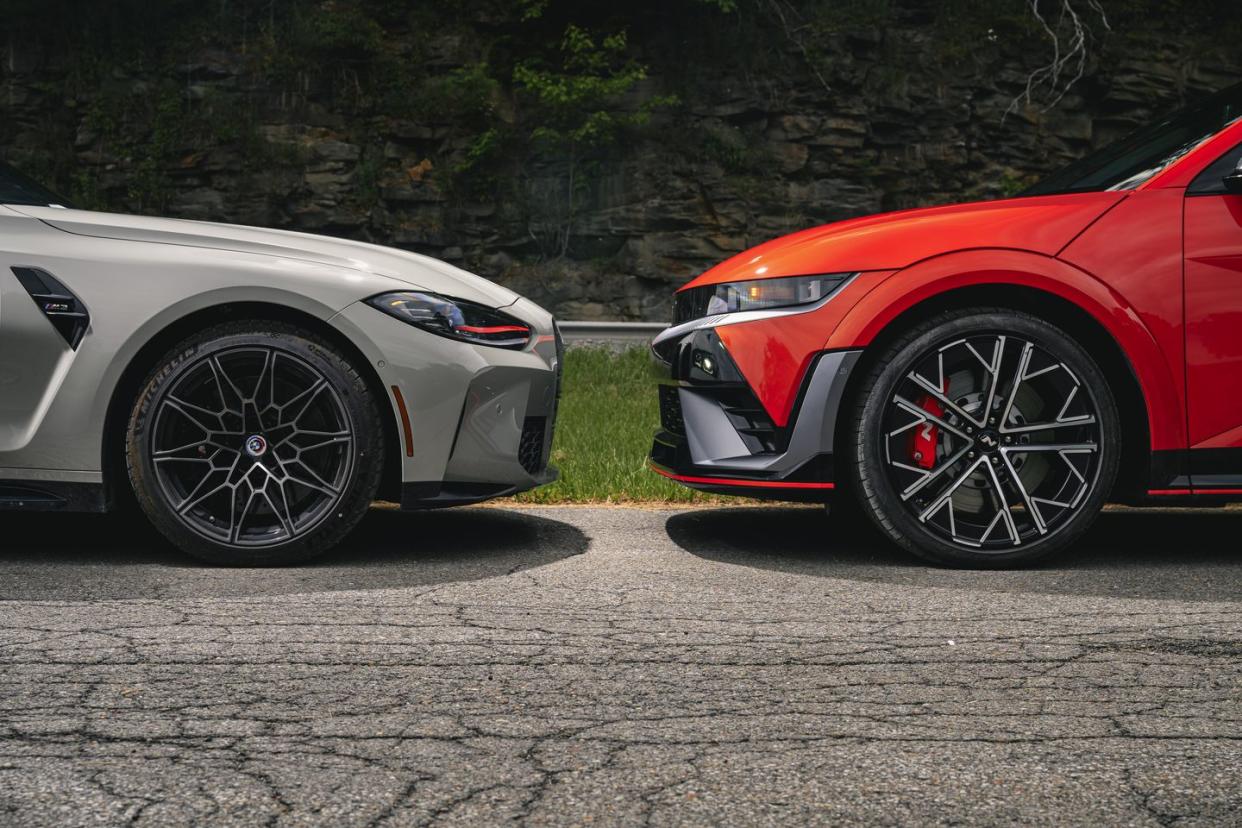
And another benefit to the 800 volts is when you make it back to a fast-charger, the 5 N gobbles up electricity. I hardly had time to go inside and pee before I’d gone from 20 to 80 percent charge, up to around 180 miles of range.
Certainly, the M3 is worth celebrating. It keeps an old formula—a rear-drive family car with a finely tuned chassis and a manual transmission—alive, and it keeps it updated with modern safety, emissions, and convenience.
The 5 N’s achievement is that it proves the modern performance-car recipe can translate to an EV. Everything we know about suspension tuning, steering geometry, and chassis setup works regardless of drivetrain choice. On top of that, the qualities we look for in an engine – modular power, sharp throttle response – can be done with electric motors. It’s an exciting moment. From the driver’s seat, it feels like a hot rod kind of project, experimental still. Trying things out. Seeing what sticks.
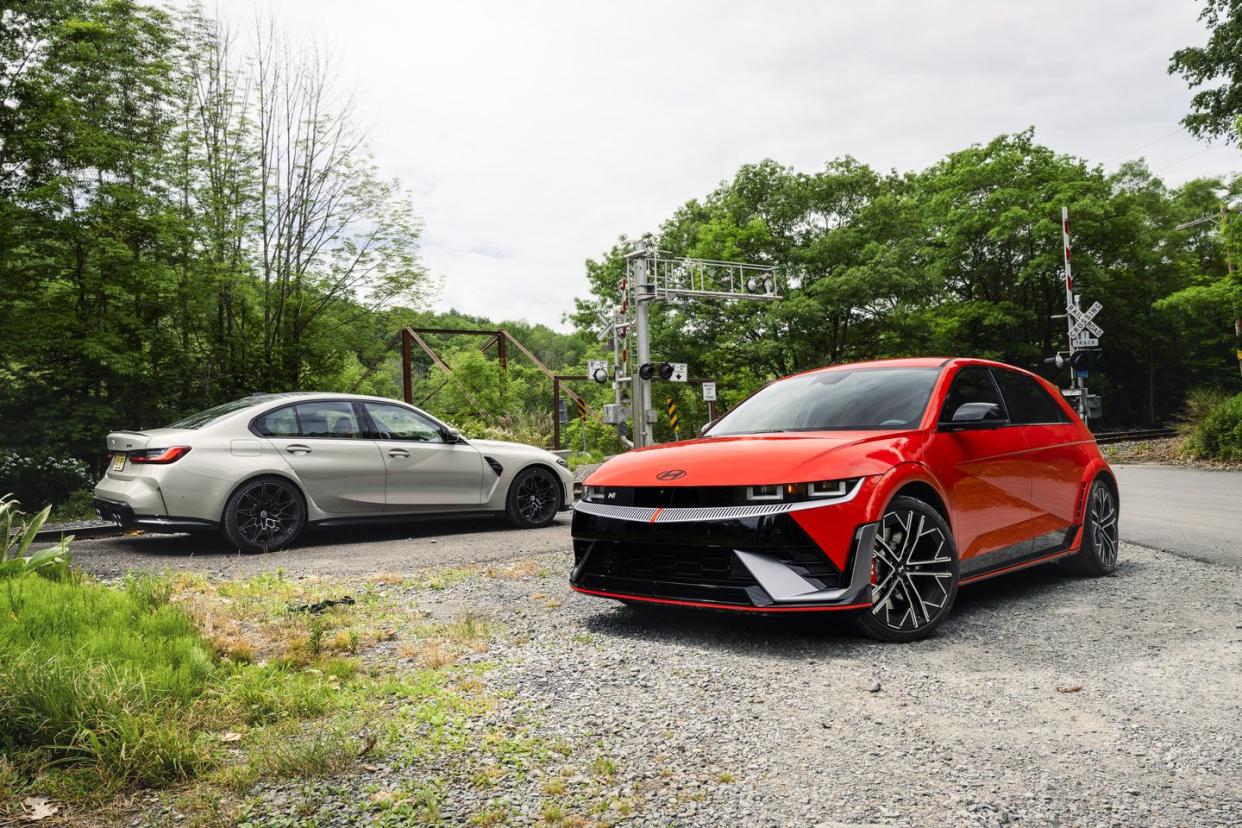
Which One Do You Want to Buy?
On the basis of how these two vehicles handled alone, I preferred how the 5 N drove.
But it’s close. These are both so good when driven hard. I’d only give a slight advantage to the Hyundai, if only for how eagerly it attacks turns. Heavy as it was, the 5 N felt more nimble than the M3. More lively. More alive.
Of these two performance cars, which one would I want to own? For two of the other drivers on this test, they went back to the M3. I can’t blame them. It’s familiar. Handling aside, there is a real appeal to the M3’s manual transmission that the 5 N’s simulated gears can’t match. The other drivers liked knowing that what was going on in the M3 was mechanical, pure, and simple.
And I can see how the gimmicks of the 5 N can be distracting, how they can take your mind off of how the car drives. That’s why I left them off and focused on the raw sounds and responses of the electric drivetrain. There is a genuine car here in the 5 N. It’s new and fresh, but it’s not uncomfortable. N achieved its big goal with this thing: Anyone can get into it and be fast. Where N went above and beyond is that the deeper you dive into it, the more you uncover a standout chassis. This is the car we’ve been waiting for from N, uprating its fun front-drivers (like the Veloster N that won Performance Car of the Year in 2020) to big power and all-wheel drive. That Hyundai made a car to match the M3’s benchmark at all is a delight. That it’s electric makes it history.

A car-lover’s community for ultimate access & unrivaled experiences.JOIN NOW Hearst Owned
You Might Also Like
